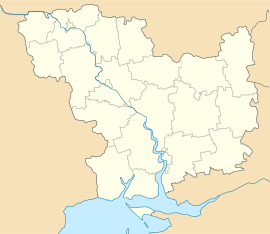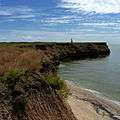Berezan Island
| Native name: <span class="nickname" ">Березань | |
|---|---|
|
Berezan Island as seen from a distance. | |
 Berezan | |
| Geography | |
| Location | Black Sea |
| Coordinates | 46°36′N 31°24.6′E / 46.600°N 31.4100°ECoordinates: 46°36′N 31°24.6′E / 46.600°N 31.4100°E |
| Total islands | 1 |
| Area | .29 km2 (0.11 sq mi) |
| Length | .9 km (0.56 mi) |
| Width | .32 km (0.199 mi) |
| Administration | |
| Region | Mykolaiv Oblast |
| District | Ochakiv Raion |
| Administered by | Olvia Preserve |
| Demographics | |
| Population | uninhabited (2001) |
| Additional information | |
| Official website | Olvia Preserve official website |
Berezan (Cyrillic: Березáнь; Ancient Greek: Borysthenes; former Turkish: Pirezin) is an island in the Black Sea at the entrance of the Dnieper-Bug Estuary, Ochakiv Raion, Mykolaiv Oblast, Ukraine. It is often being confused with the artificial island of Pervomaisky that is located within Dnieper-Bug Estuary. The Berezan island measures approximately 900 metres in length by 320 metres in width. It is separated from the mainland (to which it may have been connected long ago) by about a mile and a half of shallow water.
History
Berezan was home to one of the earliest Greek colonies (possibly known as Borysthenes, after the Greek name of the Dnieper) in the northern Black Sea region. The island was first settled in the mid-7th century B.C.[1] and was largely abandoned by the end of the 5th century B.C., when Olbia became the dominant colony in the region.[2] In the 5th century BC, Herodotus visited it to gather information about the northern course of the eponymous river. The colony thrived on wheat trade with the Scythian hinterland.
In the Middle Ages, the island was of high military importance because it commanded the mouth of the Dnieper. During the period of Kievan Rus’ there was an important station on the trade route from the Varangians to the Greeks. It was there that Varangians first came into contact with the Greeks.
.svg.png)
The only Runic inscription in Southern Ukraine, the Berezan' Runestone, was found on the island in 1905, now on exhibit in the Odessa Historical Museum. The inscription seems to have been part of a gravestone over the grave of a Varangian merchant from Gotland. The text reads: "Grani made this vault in memory of Karl, his partner."[3]
The control of the estuary (known in East Slavic sources as Beloberezhye, or White Shores) was disputed between Kievan Rus and Byzantium during the multiple Rus'–Byzantine Wars. At last the Rus'–Byzantine Treaty of 944 stipulated that the Rus' could use the island in the summertime, without establishing winter camps in the estuary or oppressing the citizens of Chersonesos fishing off shore. Nevertheless, at the conclusion of Svyatoslav I's war against Byzantium, this overking of Rus was allowed to evacuate his forces from Dorostolon to Beloberezhye, where his troops spent the hungry winter of 971/972.
Zaporozhian Cossacks revived Berezan' as a fort during their campaigns against the Crimean Tatars and the Ottoman Empire in the 16th and 17th centuries. After the fall of neighbouring Ochakov to the Russians, the island was incorporated with the remainder of New Russia into the Russian Empire.
The site of the Greek colony and its necropolis have been periodically excavated since the 19th century; even though the site has suffered from erosion (and the tombs also from looting), the digs produced rich findings (archaic ceramics, inscriptions, etc.).
In March 1906 here was executed Pyotr Schmidt.
Gallery
-

Archaeological excavations of Borysthenida on the island
-

Abandoned lighthouses
-

Obelisk to commemorate Lieutenant Schmidt
-

Flying over Berezan Island in a Cessna 150L
Notes
- ↑ Eusebius states in his Chronikoi kanones that the colony was founded in 647–646 BC, by settlers from Miletus.
- ↑ Treister, Michail J.; Vinogradov, Yuri G. "Archaeology on the Northern Coast of the Black Sea", American Journal of Archaeology, Vol. 97, No. 3. (1993), p. 538.
- ↑ Entry X UaFv1914;47 in Rundata 2.0
Further reading
- Krÿzhitskii, Sergei D. "On the Types of Houses on the Island of Berezan", Ancient Civilizations from Scythia to Siberia, Vol. 11, Issue 3/4. (2005), pp. 181–197.
- Noonan, Thomas S. "The Grain Trade of the Northern Black Sea in Antiquity", American Journal of Philology, Vol. 94, No. 3. (1973), pp. 231–242.
- Solovyov, Sergei L. Ancient Berezan: The Architecture, History and Culture of the First Greek Colony in the Northern Black Sea (Colloquia Pontica; 4). Leiden: Brill Academic Publishers, 1999 (hardcover, ISBN 90-04-11569-2).
- Reviewed by Balbina Baebler in the Bryn Mawr Classical Review, 2000.06.01.
- Reviewed by Sara Owen in The Journal of Hellenic Studies, Vol. 121. (2001), pp. 216–217.
- Solovyov, Sergey L. "Berezan Island: The Main Features for Archaeology", Bilkent University. The Department of Archaeology & History of Art Newsletter, No. 3. (2004), pp. 17–19.
- Solovyov, Sergei L. "Monetary Circulation and the Political History of Archaic Borysthenes", Ancient Civilizations from Scythia to Siberia, Vol. 12, Issue 1/2. (2006), pp. 63–75.
See also
- Khortytsia Island
- Snake Island

